
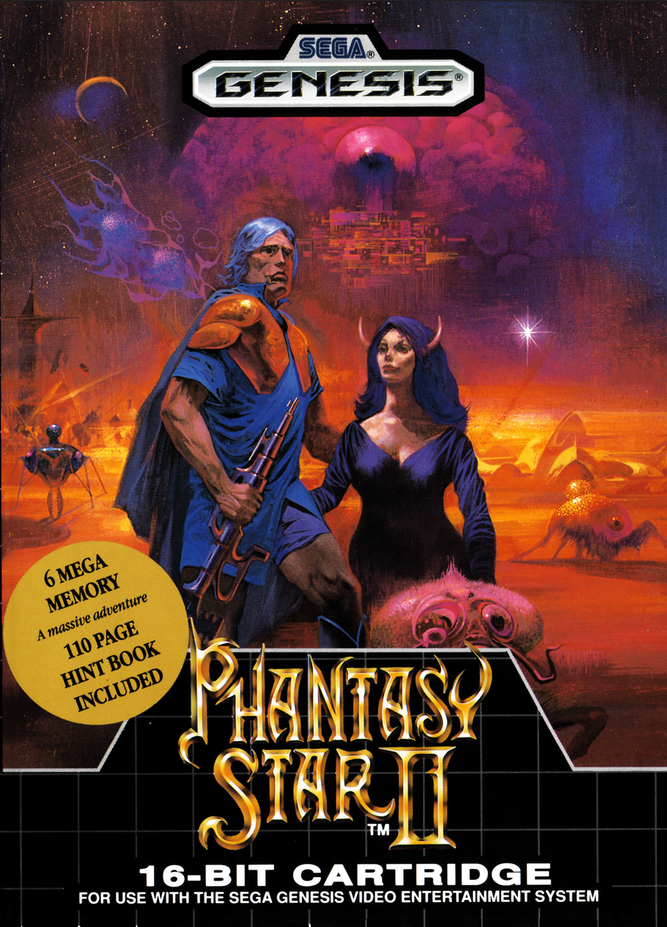
PLAYERS: 1
PUBLISHER/DEVELOPER: Sega
GENRE: RPG
RELEASE DATE: 03/21/1989 – (JP), 01/1990 – (US), 02/1991 – (EU)
Phantasy Star was a bold RPG that proved Sega could make games outside of their comfort zone. Up until this point, Sega’s forte was the arcade: racing games, shooting games, all made with the latest technology, all as in-your-face and body-rocking as possible. The Master System couldn’t bring the arcade experience home (though Sega tried their darndest), so Sega had to expand their limited repertoire. Thanks to Dragon Quest, RPGs were becoming popular on home consoles in Japan, so it made sense for Sega to try their hand at one. Nobody expected how great Phantasy Star would actually be. The melding of fantasy characters with sci-fi worlds, the landmark cutscenes, traveling from planet to planet. The original Dragon Quest and Final Fantasy were landmark titles, but their scope feels small compared to Phantasy Star.
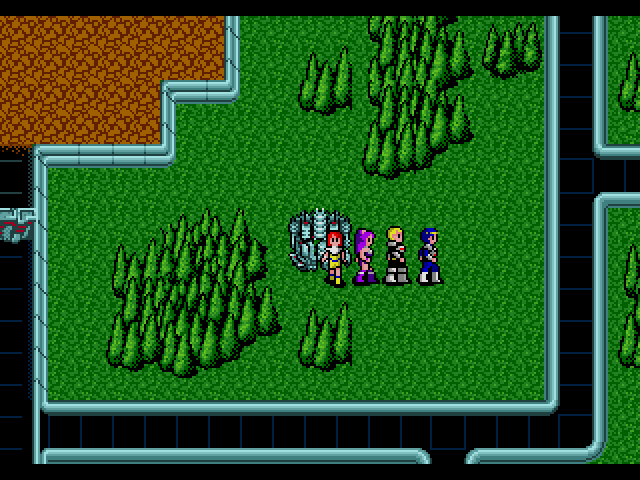
Phantasy Star II fans claim that it’s just as groundbreaking as the original, but I’m not sure I buy that. At least not yet. By all indication, I’m not even halfway through the game, despite playing a rock solid twenty hours or so. Here’s a look at my playthrough thus far: walk a few steps to the next area, grind a lot on the way, get a new character who starts at level 1, grind so the character will stay alive for future fights, grind for money for new items, grind so I don’t die at the next dungeon that’s literally right around the corner (yet is much harder than anything I’ve experienced thus far). Phantasy Star was grindy, no question, but when forced to take a couple hours to level up my party, I was rewarded with a rocket ride to another planet or the destruction of a super huge dungeon. The only reward given for gratuitous grinding in Phantasy Star II is knowing that I might survive the next portion before being forced to grind for hours again.
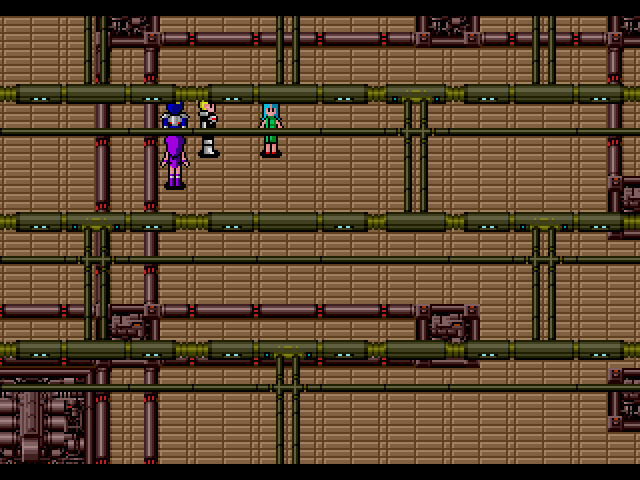
The story takes place a thousand years after the original Phantasy Star, with protagonist Rolf taking over for Alis. As the game opens, Rolf is having recurring nightmares of a strange woman (that resembles Alis) battling a dark entity. Right before the entity kills her, Rolf awakens. He’s then summoned to a government building and asked to investigate the mysterious increase in biomonsters all around the planet Mota. From there, your adventure begins.
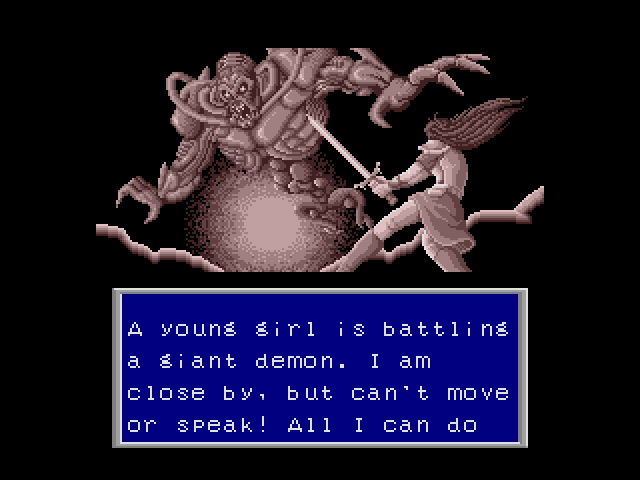
Initially, Rolf is joined only by his half-human, half bio-hazard girlfriend Nei. With each new town you enter, however, a new character will appear at Rolf’s house in Paseo. There are eight characters total, including Rolf and Nei, though you can only have four in your party at a time. Each of the characters is useful in their own way. Rolf is a handsome government agent tasked with solving the world’s problems. Nei is his strong, sensitive girlfriend, loyal ’til the end. Rudo is a biomonster hunter who’s “good with a gun.” Amy is the important doctor/healer of the group. Hugh is a biologist who knows a lot about biomonsters. Anna is a guardian, out to kill evil hunters with her dual blades. Kain is a pro at dismantling robots. Finally, Shir is a thief who tags along with you for fun.
They’re a neat group of characters, but even after twenty hours of grueling toil, I know very little about any of their personalities. If anything, I look at them as chores. For example, Kain starts off at level 1 when the rest of your characters are about level 12. To get Kain up to snuff, he needs to fight high ranking monsters and get enough meseta to buy higher-level armor, so he can stay alive to fight more monsters. Do I need Kain when he first shows up to Rolf’s house? Not right away. But the more I grind to get him to a reasonable level, the less grinding I’ll have to do later when his presence in my party is imperative.
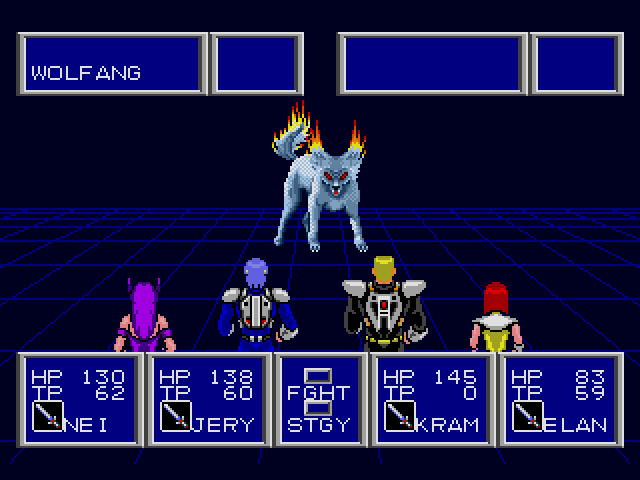
In RPGs that provide a plethora of characters, it’s usually not necessary to build up everyone. Phantasy Star II is not like other RPGs. You’re given these eight characters for a reason: to make your life easier. Sure, you could beef up your four favorite weirdos and try to tackle every dungeon in the game. But at some point – at some crucial turning point – you’re gonna need Shir to steal an item for you. Or Kain to put the hurt on some high-level robot. Or Hugh to do… whatever Hugh does. I personally haven’t reached these points yet, but I know they’re coming.
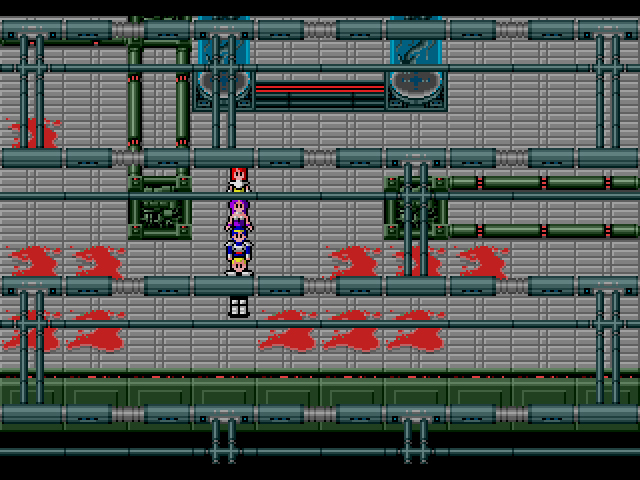
In the first Phantasy Star, the dungeons were claustrophobic caverns that held both treasure and danger in abundance, and the first-person viewpoint helped you feel like you were part of the action. Phantasy Star II removes the first-person view entirely. Whether you’re deep in creature doo-doo in a dungeon or exploring Mota at large, your party is always seen from a top-down perspective. I have an idea why Sega shifted: first-person was mostly seen in CRPGs, while the burgeoning JRPG (Dragon Quest and its many imitators) kept first-person limited to battles. That being said, I miss first-person in the dungeon. While the top-down viewpoint allows you to see how vast the dungeons are, the intimacy is lost. The dungeon design isn’t as inviting in Phantasy Star II, either. The ones I’ve explored thus far are (mostly) dull, complicated webs of machinery designed to frustrate the hell out of the player. Unless you have the old hint book that came with the game upon release or an FAQ, may Mother Brain have mercy on your embattled souls.
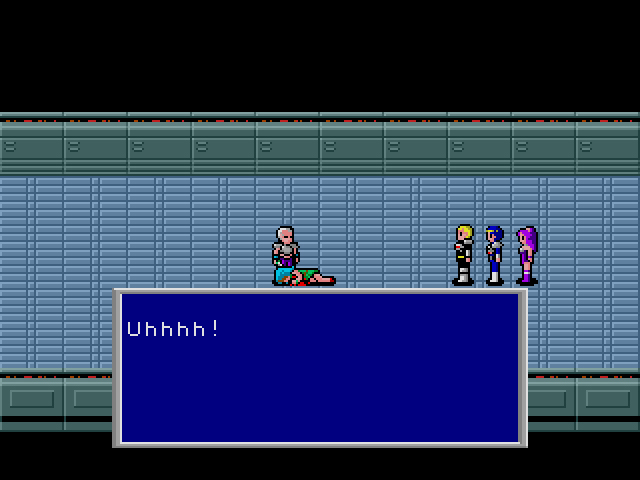
Sega’s tweaks to the battle system were for the best. While the turn-based combat remains the same as in the original, your party is now viewed from a third-person perspective as opposed to a first-person view. When each character attacks, you see them slice or shoot the enemies in front of them. It’s a neat graphical flourish that’s only possible with advanced Mega Drive hardware. The battle menu has also been streamlined for maximum efficiency. You have two options, Fight and Strategy. Fight lets you attack without customization, while Strategy allows you to either focus attacks on a specific creature, use Offensive or Defensive Techniques, defend without attacking, or use items. The simplified menu layout keeps battles moving smoothly and quickly, and was the perfect design choice for a game this battle-heavy.

The greatest challenge for me in Phantasy Star II so far has been to maintain an interest in the game. I’m using an FAQ to (in theory) move forward at a brisk pace, and I’m following my guide’s advice almost down to the letter. I’m grinding like mad to strengthen my characters and get mesetas to buy expensive crap that will only be good until the next town, a couple blocks over. Even though this is beyond tedious, it’s totally necessary. Even with the best equipment, you still take deadly hits and your party requires constant upkeep. Despite performing this cycle for twenty hours, I still don’t feel like I’ve gotten anywhere. By this point in Phantasy Star, I had explored all of Palma and the desert planet, Motavia. I know Phantasy Star II is a larger game than its predecessor, but like expansive open-world games that require you to perform thousands of mundane tasks in lieu of plot, larger doesn’t always mean more enjoyable.
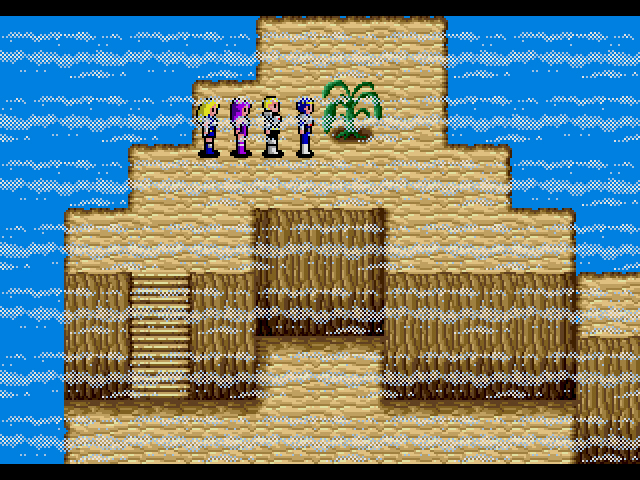
Before I get lots of angry comments, please keep in mind that this is only the first part of a two-part review. For all I know, Phantasy Star II will become the enthralling blockbuster followup that I want it to be. The worst part is, I typically enjoy grinding. I love the original Phantasy Star, which had plenty of grinding. I gave all four Dragon Warrior games high marks, and the first two games in that series are all but unplayable today. Phantasy Star II is not like the aforementioned games. You will grind to hell and back. My eyes are dry. My butt is numb. The music, which I initially liked, has become a gruel of synths clogging up my ear canals. And what do I get in return for hours of servitude? Harder enemies, shinier swords, and a sense that I’m wasting my life. Phantasy Star II hasn’t bested me yet, but the struggle to continue is real.

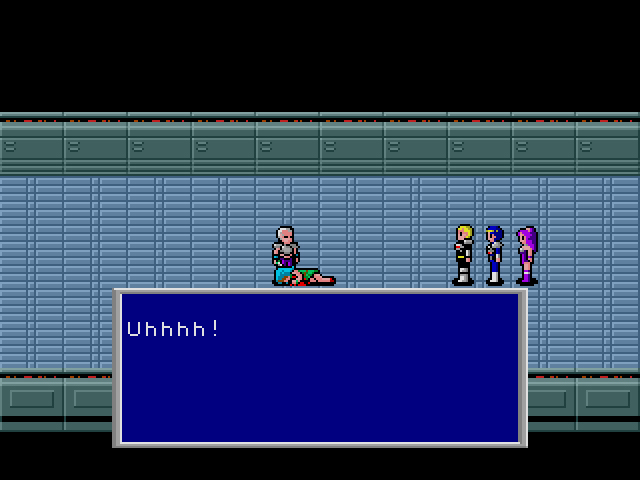
17 replies on “Phantasy Star II: Part One (Genesis, 1989)”
This was only the second JRPG I ever played, I played it through on the Mega Drive Ultimate Collection.
But I did heavily rely on a guide not only for tips but to tell me what level my party needed to be at so I could grind appropriately.
I did really enjoy playing it, tough but making sure you were at the right level made it manageable. I also find the Phantasy Star Universe more interesting than say the Final Fantasy universe (at this point in time).
Is it a classic like the first game ? I would say not but a strong title nonetheless. Unfortunately the third entry is definitely a step back in both style and quality, but the 4th one is sublime.
There is a reason I have not touched Phantasy Star 2 since my first playing back in ’93. It’s just not fun, and a lot of work. That and combined with the boring blue fighting grid and over the top dungeons make it an inferior game to the first. I want to see colorful and animated backgrounds like the first had. I want to explore three planets instead of two. PS2 tries too hard to be superior to the first but it fails in almost all aspects.
I did enjoy the ending which made the difficult journey worth it but I’ll never do it again. Once was enough. However, there may be a chance I’ll dust off PS 1 or 4 so my younger boys can experience the series.
I totally agree with your thoughts so far. The game is a lot of work.
This is a game I need to go back to. I bought a used copy back in ’93 or ’94, when I was attempting to broaden my Genesis library’s horizons, and was instantly intrigued with it, but since I didn’t get the guide, I was instantly overwhelmed by the confusing dungeons and steep difficulty curve. I had done a little grinding in my previous RPG experience, Final Fantasy Legend on the Game Boy, but wasn’t prepared for the kind of grinding I’d have to do here. I found out later, with Final Fantasy 7 and Lunar: Silver Star Story Complete on the PlayStation, that such a thing is commonplace among JRPG’s, and though I’m still not a huge fan of the genre, I understand the necessity of it. That said, I agree that the music, while good, can get SUPER repetitive after a while. I like the soundtrack, but there are a total of 22 tracks in the whole game, including the title screen theme. Thankfully, the battle music is at least decent, but there’s just not enough varied music throughout.
On a funny side note, that used copy had a save file with the party in the building at the end, just before the conflict with Mother Brain. Either that battle is ultra hard, or the previous owner hadn’t leveled up sufficiently beforehand, because I think I tried 40 times to beat her, with no luck. Perhaps one day I’ll go back and take another crack at it.
Yeah, I’ve played my fair share of JRPGs, including older ones that focus on battles and little else. Phantasy Star II tops them all when it comes to grinding.
I found the original Dragon Warrior to be far less enjoyable in the grinding department, if only because of it simple and monotonous nature. I played Dragon Warrior after playing Phantasy Star 2. I believe Phantasy Star 2 actually came out before Dragon Warrior in the U.S.
Dragon Warrior came out in August of ’89 in the US, while Phantasy Star II hit the streets in early ’90.
I played (and finished!) this game back in ’90/91, not soon after it came out. Back then, I absolutely loved it – I spent countless hours, grinding, earning mesetas, trying out different equipment to figure out what worked, and most of all, traversing every inch of the dungeons in order to create my own maps so I could figure out how to get through.
Unfortunately, I think this is a game that will stay great in my mind, but I would never want to attempt today. While taping together sheets of graph paper to display my completed dungeon maps filled my 10 year-old self with a sense of pride and accomplishment, my adult self has neither the time nor energy to spend on this. These days, I much prefer RPG’s with more plot, more character development, and less busywork.
All that being said, the plot is good in Phantasy Star II, and the game was amazing for its time – a time where (most) people generally got half a dozen games in a year, and played those games to death. Back then, the requirement to keep a gamer’s attention was not nearly as high as it is today, so the grinding made sense – it lengthened your time with the game, and you were grateful for it.
“Back then, the requirement to keep a gamer’s attention was not nearly as high as it is today, so the grinding made sense – it lengthened your time with the game, and you were grateful for it.”
This is the best explanation so far for why the game has so much grinding. And for why the dungeons are just awful labyrinthine complexes. Sega assumed and probably even hoped that players would get lost.
Can I mention how much I’ve always hated the US box art. Why are they so old?
Looks like it should be for an Ultima game, not PSII.
And why does Nei have horns? (Which gets a shout-out in Phantasy Star IV. “These are ears I tell you!”)
Having played through a part of this game, I find this review to be very fair and well-reasoned. The game IS a grind-fest. Fun, pretty, groundbreaking, but grindy. Like you, I can and do play Dragon Quest games and enjoy the hell out of the grind. Ditto the FF series (particularly the old ones). I also liked PS1, but this just didn’t “grab” me enough to want to finish it. I do intend on getting back to it some day.
One thing I dig about this blog, as well as Questicle, is that you’re very critical and analytical and unafraid to slay some sacred retrogaming cows when warranted. Never apologize! Keep doing your thing. And when you finally get to your “Playing the Fourth Station” blog or “I’ve Gotta Take A Wii . . . U?” in the year 2035, we’ll delight to you setting the record straight on “Fallout 4” and “Really Ultra New Super Mario Brothers.” Provided I’ll be able to find my glasses by then.
Phantasy Star II is a beast. If I wasn’t playing it for the blog and if I hadn’t been encouraged by several people to keep playing it, I would have given up.
And thanks for the encouragement! It’s not that I mean to slay sacred cows, but I do feel it’s important to try and look at these games from the perspective of when they were released and today. It’s difficult, but worthwhile.
And heaven help me if I’m doing a chrono-blog in 2035…
Even the good writers need some encouragement from time to time. I never got the impression you TRIED to be contrarian, but when the opinion is honest it’s good to see things from another perspective. I’m thinking of your Crystalis NES review, for example–a game I personally love that you were lukewarm about–or your willingness to revisit Fester’s Quest (a brave task, mainly because that game is, in my opinion, just so bad). Even your The Legend of Zelda rating goes against the grain. It’s all good stuff and makes the reviews worth reading.
And finally, if you are doing a chrono-blog in 2035, you’re clearly doing it wrong. The idea is to have your future children carry on your legacy.
I agree with you and with Raiden above. Phantasy Star II is a substantial retrograde step from the first game and the trough continues through PS III, albeit for different reasons. I think you’ll enjoy IV a lot more. It’s easier and has a lot more charm.
I can’t believe I have to play III so soon. Sega really busted out the sequels quickly.